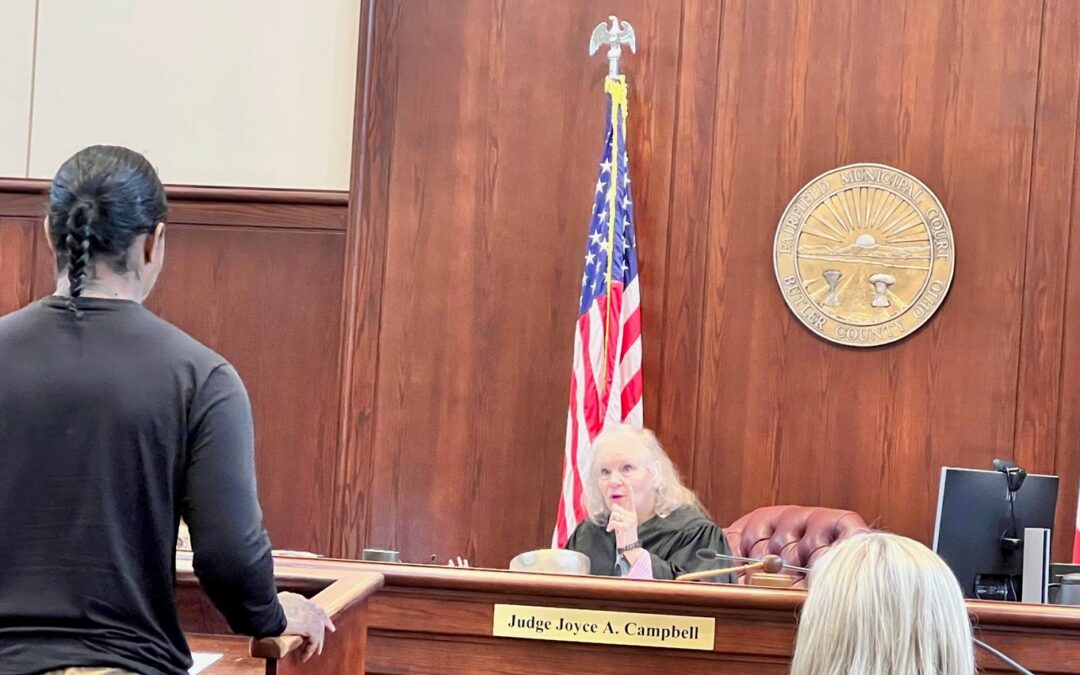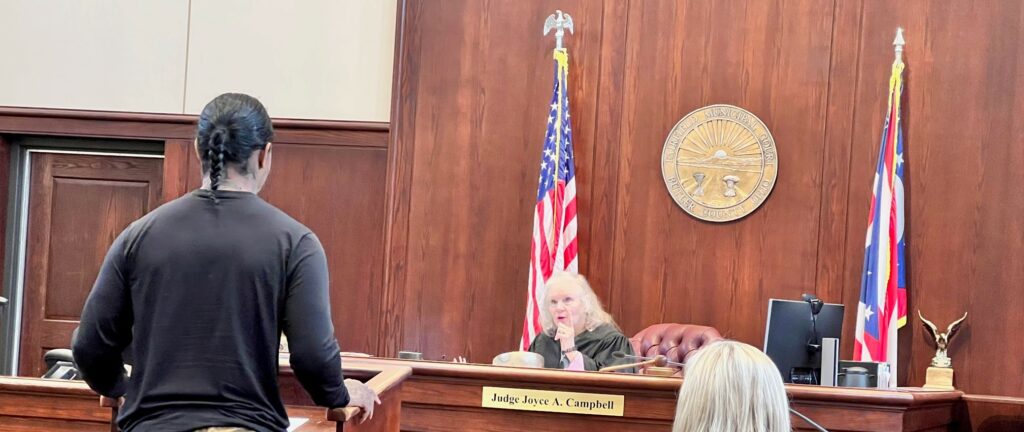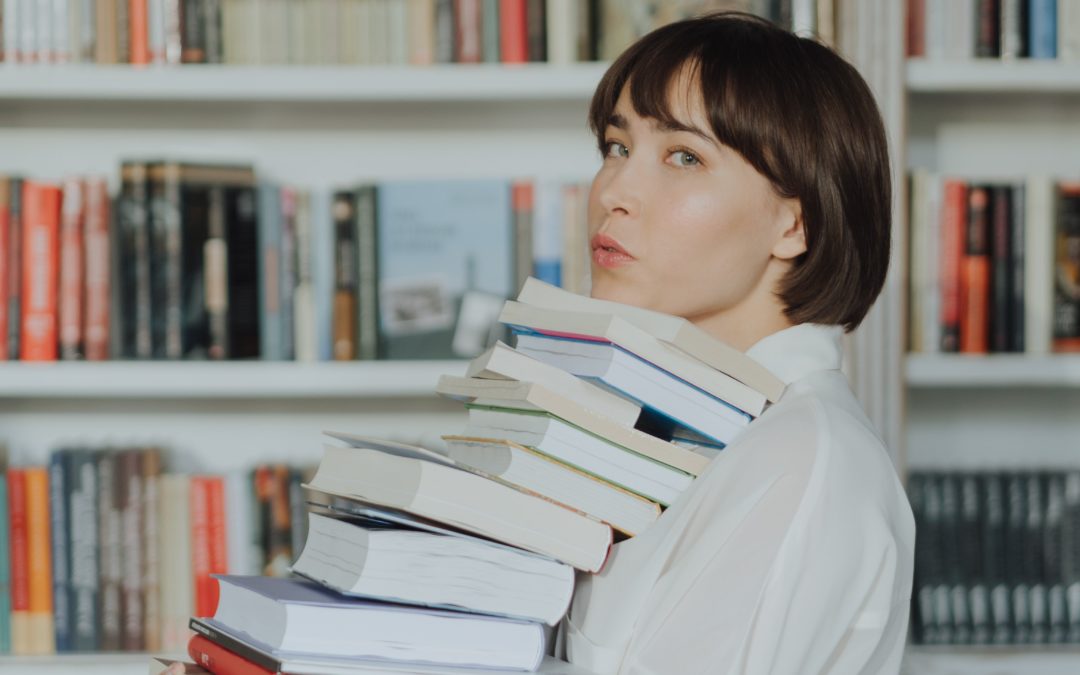
by NAMI Ohio | Jun 15, 2023 | Blog

Written by: Alan Johnson, NAMI Ohio
FAIRFIELD, OH – Judge Joyce A. Campbell’s Fairfield Municipal Courtroom looks like any other: a judge in a black robe, a jury box, witness stand, tables for attorneys, and armed law enforcement.
But when the gavel comes down in the Fairfield Municipal Court Treatment Alternative Court (TAC) you see things are very different in this courtroom.
TAC is a special court where Judge Campbell deals with misdemeanor offenders who have been diagnosed with a serious mental illness. While TAC is voluntary, those sent to Judge Campbell’s court are there in hopes of avoiding jail on misdemeanor charges whenever possible. Instead, they receive alternative sentences – mental health and physical health treatment, access to drug and alcohol programs, and case management to help with employment, education, housing, and transportation.
Ohio has 40 mental health courts, which are among a total of more than 249 specialty courts for drunk driving, drug abuse, human trafficking, veterans, and other offenses.
Judge Campbell, who is national president of the National Alliance on Mental Illness and a NAMI Ohio Board member, is a leading advocate of helping people with mental health issues avoid being trapped in a court system where they often end up behind bars where their mental illness remains untreated and sometimes worsens.
“This is where my heart is. People with mental illness have been treated very poorly by the criminal justice system,” Judge Campbell said after a recent 90-minute TAC session where she handled 16 cases. Most people remain under court supervision for one to two years.
Judge Campbell deals on a first-name basis with everyone who appears before her. She alternates between being complimentary and supportive of those who have made positive efforts, and sharply critical while warning offenders who have run off track that jail time is a real possibility.
“I’m not asking you. I’m telling you,” she said to one young man who failed several mandatory drug tests. “The alternative is jail, and I don’t want to do that.”
Now and then, Judge Campbell finds no alternative. A woman she previously sentenced to jail for violating her probation appeared in court in shackles dressed in a Butler County Jail uniform. She told the judge, “I’m going to remain sober. I’m done now.” She said she spent her 33rd birthday in jail without a celebration or a birthday cake.
“Do not do anything. They’re going to drug test you,” Judge Campbell said after agreeing to release the woman the next day. She sweetened the deal by promising her “a real cake” if she stayed clean and sober until her next court date in July. “Do you want chocolate or vanilla?” the judge asked. She wanted vanilla. “We’ll have cake,” Judge Campbell said.
In another case, she excused herself from the bench in the middle of talking to a man who said he mediated to calm himself to avoid repeating past mistakes. She returned a few minutes later from her office with a Tibetan singing bowl, a brass bowl that makes soothing sound vibrations when struck with a wooden mallet. She demonstrated and told the man, “Get yourself a singing bowl.”
No two cases in the Fairfield TAC are treated the same. Judge Campbell praised some but gave stern warnings to others who made repeated mistakes.
“Two steps forward and one step back. I don’t want to cha-cha with you. You’ve got to start thinking, young man,” she said. “Your actions have consequences.”
To another, she said, “You’ve got an incredibly bright future, I don’t want you to blow that up.”
A man who had missed a previous court appearance got a tongue-lashing. “These are not invitations from the court. These are orders from the court. They will come and take you to jail.”
Judge Campbell was amazed to learn one offender smoked marijuana the day before he appeared in her court.
“It interferes with your psychotropic medication,” she told him. “And I can’t tell you how many times I’ve had people in this court who thought they were smoking a little weed and it turned out it had fentanyl in it. Do you know what happens then? You end up dead.”
Most people who appear in Judge Campbell’s court are referred by police, prosecutors, or the public defender in hopes they can be rehabilitated without serving jail time. In most cases, they can also get their record expunged because a criminal record is a major handicap for former offenders seeking employment and housing.
The most common diagnoses of those in TAC are bipolar disorder, major depression, and schizophrenia. Some also have developmental disabilities and drug issues as well.
The judge partners with a team in her courtroom, including Max Bryant, a probation officer assigned to the court; Tina Barrett, an attorney from the public defender’s office; Amy Crouch and Brandi Justice, from TLC Transitional Living, an agency offering counseling, psychiatric service, and residential care, and Maxine Seelenbinder-Apke or other representatives from NAMI Butler County. A city prosecutor sometimes sits in as well.
TAC is not a get-out-of-jail-free card. Offenders must follow a lengthy, specific set of rules, including abstaining from drugs and alcohol, attending counseling appointments and drug tests as required, taking prescribed medications, paying court costs and fines, and avoiding further run-ins with the law. They pay a diversion fee and monthly charge for probation reporting.
While TAC is the most time-intensive of Judge Campbell’s assignments, she has many other unrelated civil and criminal cases – a total of about 10,000 per year.

by NAMI Ohio | Dec 2, 2022 | Blog, News & Updates
Written & Submitted By: Danei Edelen

Nothing says spring like the feeling of fresh air blowing through our house on a warm spring day like the afternoon after the Georgetown Community Day at Georgetown Elementary. After two years of isolation, I think everyone was looking for an excuse to get out of the house and be around people again. “Working a booth” was a quiet victory for both Anita and I. Anita and I had met five years earlier when I founded NAMI Brown County. We have been through a lot in the last five years, the death of her son, me being hospitalized three times, COVID, and the war in the Ukraine. As I remarked to Anita in the car, “We are just grateful to be well enough to work a booth”. Welcome to a new chapter in our lives. Watching Anita console a grieving mother with the touch her hand, validated again for me today why I founded NAMI Brown County. “Together, we are making a difference, one day at a time, one life at time.”
My name is Danei Edelen. I am founder of the NAMI Brown County Ohio affiliate. In July, we will be celebrating five years for NAMI Brown County at the Child Focus on July fourteenth. Becoming known in my community as founder of NAMI Brown County brings me a quiet thrill. In April, I spoke at the Brown County Chamber of Commerce luncheon to tell people about the party. I was so nervous, that I could hardly touch my food. A woman from one of our community banks came up to me at our NAMI booth at the Georgetown Community Day and told me I had done a nice job. “Why, thank you!” I said with profound relief.
Part of the reason this party means so much to me is because I have lost two people in my life to suicide as well as having my own suicide attempt. I have lived through that dark night of the soul related to suicidal thoughts. NAMI was a lifesaver for me. I am convinced that if had known about NAMI before, I would have found the help I needed.
Suicide has become an epidemic in this country. Suicide is now the second leading cause of death for people ages 10-34. The 988 Implementation Act, introduced by Congressman Tony Cárdenas, provides federal funding and guidance for states to implement a 988-phone number to replace 911 for mental health crisis calls. The 988 Implementation Act provides funding for a crisis response infrastructure that relies on trained mental health specialists instead of armed law enforcement. NAMI Brown County also has free Zoom calls on the second and fourth Thursday of the month. If you or someone you know is struggling, please know that you are not alone. Anita and I are living proof that there is life after a mental illness diagnosis.
Learn more about Danei and download a copy of the article HERE

by NAMI Ohio | May 6, 2021 | Blog
Written by: Alan Johnson
Julie fears her grandson is lost, the victim of a mental health system that repeatedly failed him for years.
Jacob, Julie’s 21-year-old grandson, has multiple mental health diagnoses, triggered in infancy when his mother abducted and took him out of state where she frequented crack drug houses. He developed what is known as “reactive attachment disorder,” which occurs when very young, abused, and neglected children have no feeling of safety and security. Jacob’s reaction to a crisis is fight or flight.
“He’s going to be a statistic,” said Julie, who now works in a long-term care facility after previously being employed at a hospital. “I think the health care system, the mental health system, and the schools all failed him. He was a child left behind,” she said.
Jacob’s story is all too common in a fragmented and underfunded mental health system that focuses on what services are available and not what the person needs.
After being abducted to Colorado, Jacob ended up in foster care before Julie and her husband brought him back to Ohio. The problems started almost immediately. She took him to counseling and Jacob was placed on medication at a young age.
Jacob moved to live with his father at age 10, but things just got worse, with the boy ending up at a juvenile facility after police came and picked him up at his elementary school. “I never send them this young, but I don’t know what else to do,” Julie remembered the judge saying in court.
Since then, Jacob has been in and out of psychiatric hospitals, has been arrested frequently, and spends most days in adult care facilities. But he runs away often, and sometimes walks down the middle of the highway, and has said he wants to die – “to be smashed on the road like a deer.”
When the police come, Jacob often resists and throws rocks and bottles at them, his fight or flight response from childhood kicking in.
At one point, when Jacob was being dropped at a hospital for psychiatric treatment, a police officer told him he faced four criminal charges when he got out. That made things worse for the troubled young man.
Through it all, in 18 years since coming back to Ohio, Jacob has not received the consistent mental health treatment he so desperately needs.
Julie has not given up on Jacob, and never will. But, she said she has run out of options.
‘I have taken him to counseling for years. It’s emotionally and physically draining to go through this over and over again. We’ve done everything we’ve been asked to do.”
She continued, “I love him. He’s innocent. He did not ask to be like this.”
“I feel scared for his future. I feel there’s no way he can have any sense of normalcy in this life. He’s not a criminal. He just needs help.”

by NAMI Ohio | Mar 31, 2021 | Blog
“Wisdom is not a product of schooling but of the lifelong attempt to acquire it.” Albert Einstein
Have you ever felt like you are operating on autopilot? So often we establish our daily routines and find ourselves doing the same things over and over again, often without even thinking too much about it. While there is certainly comfort and stability in routine, it can also make us feel like life has become too predictable and a little boring. One of the best ways to both exercise your brain and challenge yourself is to commit to learning something new. It can be something small and relatively easy to do, like reading an article about a topic that interests you, or it can be something large and may require a significant commitment, like growing a garden. Either way, there are many benefits that can be felt by learning something new. Research has shown that ‘mental sweat’ helps your brain build new cells and strengthen connections between the cells; specifically, when you learn something new you are exercising your brain, which can help improve cognitive functions such as concentration, attention to detail, memory recall and problem-solving, and also reduce the chance of developing dementia1. Additionally, learning something new can create a sense of achievement; specifically, setting yourself a goal to learn something new, then achieving it, is super rewarding and gives you a sense of accomplishment1. Finally, learning something new can be a lot of fun and you may find it really enjoyable to be pushed out of your comfort zone when you try something new1.
The sky is truly the limit when it comes to finding new and interesting things to learn. There are many lists available online and talking with friends or family is sure to also help brainstorm some things you have always wanted to try.
Here are some ideas of new things that you can try to not only build your knowledge but also increase your feelings of accomplishment:
• Learn a new language (or at least a few phrases)
• Learn to play a new game (board, card, or video)
• Learn about a foreign place (watch a documentary or do online research)
• Learn to play an instrument (take private lessons or watch tutorials)
• Learn to build something (it can be big or small, for use or decoration)
Photo by cottonbro from Pexels
https://www.healthnavigator.org.nz/healthy-living/l/learning-new-things-the-benefits

by NAMI Ohio | Mar 20, 2021 | Blog
“Drinking water is essential to a healthy lifestyle.” Stephen Curry
We hear it all the time: drink more water! Sure, it does not have caffeine or sugar, but what is the big deal about this clear drink? According to experts, there is a lot of positives to drinking enough water each day and staying hydrated. Perhaps the most well-known purpose of staying hydrated is that water helps the body to excrete waste through perspiration, urination, and defecation1. It helps fight off illness and can help prevent certain medical conditions such as kidney stones, exercise-induced asthma, urinary tract infections, and hypertension(1). Staying hydrated also helps to create saliva and prevent constipation, as well as aids in digestion, nutrient absorption, and weight loss(1). Drinking enough water each day maximizes physical performance, improves blood oxygen circulation, keeps skin bright, and regulates body temperature in addition to protecting your tissues, spinal cord, and joints(1). Your water intake is also linked to boosting energy, improving mood, and increasing cognitive function(1).
Clearly drinking enough water is linked to a multitude of physical and mental health benefits, so how can you make sure you are getting enough? Research has shown that most people get about 20% of their daily water intake from food so ideally, you would need to consume between about 73 ounces (2.12 liters) to about 100 ounces (3.0 liters) of water and water-based beverages daily to ensure proper hydration(1).
Below are some tips to help increase your water intake each day(2):
- Add some flavor: steeping fresh fruit (grapefruit, strawberries, lemon), veggie slices (cucumber, ginger, celery), and herbs (basil, mint, lavender) in your carafe can make consuming your daily ounces a little more exciting
- Connect drinking water to daily activities: making morning coffee? Drink a glass of water while you wait. Taking a bathroom break? Drink a glass of water after you finish. Making dinner at home or waiting at a restaurant? Drink a glass of water while cooking or waiting.
- Keep water bottles everywhere: having water readily accessible can make a huge impact on what we reach for when we are thirsty, so keep full water bottles in your most trafficked places as well as in bags and in your car. There’s no bad place to keep a full water bottle!
- Monitor your water intake each day: this both serves to keep you on track and lets you be proud of reaching your goal. You can use a water bottle that is marked to show progress, check in at scheduled times each day to evaluate progress, or use an app on your phone that will monitor your intake.
Photo by Pixabay from Pexels
1 https://www.healthline.com/health/food-nutrition/why-is-water-important#saliva
2 https://www.self.com/story/how-to-drink-more-water

by NAMI Ohio | Mar 17, 2021 | Blog
Happy Women’s History month! Since 1982, the United States has designated March as Women’s History month to annually acknowledge and celebrate the social, economic, cultural, and political achievements of women in addition to raising awareness about continued gender inequalities being faced still today.
One of the greatest inequalities women face is in healthcare, as, historically, nearly all research (including clinical studies and drug studies) was based on the experiences and symptoms of (white, cisgender) men; because of this, many women went undiagnosed or misdiagnosed for hundreds of years despite advancements in medical science. It was not until 1993 when The National Institutes of Health Revitalization Act began to require research studies and other clinical trials to enroll numbers of women and minority subjects representative of their numbers in society; this requirement heralded the era of government-sponsored, gender-based studies in medicine(1).
Mental illness and mental health treatment has been no different for women. For hundreds of years, doctors were diagnosing women with “hysteria” to explain away symptoms of other disorders, from endometriosis to mental health issues(2). It wasn’t until the late 20th century that people began to recognize and validate women’s mental health issues; as women began to challenge societal norms and centuries-old gender roles, women’s mental health awareness became a global talking point and physicians began to diagnose and treat these conditions with various therapies and medications(2). But progress certainly has been slow: it was not until 1980 that the American Psychological Association changed the diagnosis from “hysteria” to “conversion disorder”(2). Currently, it is estimated that 1 in 5 women has a mental health diagnosis and, while research shows that women and men have similar rates of mental illness, the types of mental health diagnoses are typically much different3. Depression is the most commonly diagnosed mental illness in women, with twice as many women experiencing depression than men(3). Generalized anxiety disorder is also twice as likely to be diagnosed in women as men, as is post-traumatic stress disorder (PTSD)(3). Women also overwhelming make up the majority of individuals diagnosed with an eating disorder (e.g., anorexia nervosa or bulimia), with some estimates being as high as 95%(3).
Many women face unique challenges that impact their mental health and their ability to access appropriate mental health treatment. The American Psychiatric Association found the following to be risk factors and barriers for women(3):
- Women earn less than men: women who are full-time workers earn about one-fourth less than male counterparts in a given year; the poverty rate for women aged 18 to 64 is 14.2% compared with 10.5% for men. For women aged 65 and older the poverty rate is 10.3%, while the poverty rate for men aged 65 and older is 7.0%
-
Women face gendered and intimate partner violence: about 1 in 3 women have experienced sexual violence, physical violence, and/or stalking by an intimate partner in their lifetime
-
Women are primary caregivers to both minor children and dependent adults: about 65% of caregivers are women and female caregivers may spend as much as 50% more time providing care than male caregivers
-
Women often face economic barriers, such as lack of insurance or inability to pay for services (including premiums and copays)
-
Women often face time/related support barriers, such as not being able to take time off work, find reliable child care, or have access to dependable transportation
-
Women often struggle with lack of awareness about mental health issues, treatment options, and available services as well as struggle with stigma
For more women-centered mental health information and resources, check out the Office on Women’s Health at https://www.womenshealth.gov/mental-health/good-mental-health or call their helpline at 1-800-994-9662 (M-F 9am-6pm EST).
Photo by RF._.studio from Pexels
1https://www.psychiatry.org/psychiatrists/cultural-competency/education/best-practice-highlights/working-with-women-patients
2https://www.rtor.org/2021/03/08/the-history-of-womens-mental-health-awareness/
3 https://www.psychiatry.org/psychiatrists/cultural-competency/education/mental-health-facts








